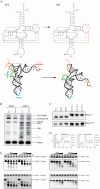Mitochondrial tRNAGlu 14693A > G Mutation, an "Enhancer" to the Phenotypic Expression of Leber's Hereditary Optic Neuropathy
- PMID: 39264244
- PMCID: PMC11538713
- DOI: 10.1002/advs.202401856
Mitochondrial tRNAGlu 14693A > G Mutation, an "Enhancer" to the Phenotypic Expression of Leber's Hereditary Optic Neuropathy
Abstract
Leber's hereditary optic neuropathy (LHON), a maternally inherited ocular disease, is predominantly caused by mitochondrial DNA (mtDNA) mutations. Mitochondrial tRNA variants are hypothesized to amplify the pathogenic impact of three primary mutations. However, the exact mechanisms remained unclear. In the present study, the synergistic effect of the tRNAGlu 14693A > G and ND6 14484T > C mutations in three Chinese families affected by LHON is investigated. The m.14693A > G mutation nearly abolishes the pseudouridinylation at position 55 of tRNAGlu, leading to structural abnormalities, decreased stability, aberrant mitochondrial protein synthesis, and increased autophagy. In contrast, the ND6 14484T > C mutation predominantly impairs complex I function, resulting in heightened apoptosis and virtually no induction of mitochondrial autophagy compared to control cell lines. The presence of dual mutations in the same cell lines exhibited a coexistence of both upregulated cellular stress responses to mitochondrial damage, indicating a scenario of autophagy and mutation dysregulation within these dual-mutant cell lines. The data proposes a novel hypothesis that mitochondrial tRNA gene mutations generally lead to increased mitochondrial autophagy, while mutations in genes encoding mitochondrial proteins typically induce apoptosis, shedding light on the intricate interplay between different genetic factors in the manifestation of LHON.
Keywords: apoptosis; leber's hereditary optic neuropathy; mitochondrial tRNA mutation; mitophagy; phenotypic expression.
© 2024 The Author(s). Advanced Science published by Wiley‐VCH GmbH.
Conflict of interest statement
The authors declare no conflict of interest.
Figures





References
-
- Zuccarelli M., Vella‐Szijj J., Serracino‐Inglott A., Borg J. J., Eur. J. Ophthalmol. 2020, 30, 1220. - PubMed
-
- Danese A., Patergnani S., Maresca A., Peron C., Raimondi A., Caporali L., Marchi S., La Morgia C., Del Dotto V., Zanna C., Iannielli A., Segnali A., Di Meo I., Cavaliere A., Lebiedzinska‐Arciszewska M., Wieckowski M. R., Martinuzzi A., Moraes‐Filho M. N., Salomao S. R., Berezovsky A., R. Belfort, Jr. , Buser C., Ross‐Cisneros F. N., Sadun A. A., Tacchetti C., Broccoli V., Giorgi C., Tiranti V., Carelli V., Pinton P., Cell Rep. 2022, 40, 111124. - PMC - PubMed
-
- Priglinger C., Klopstock T., Rudolph G., Priglinger S. G., Klin Monbl Augenheilkd 2019, 236, 1271. - PubMed
-
- Bargiela D., Chinnery P. F., Neurosci. Lett. 2019, 710, 132932. - PubMed
MeSH terms
Substances
Grants and funding
- 2021YFC2700902/National Key Research and Development Program, Ministry of Science and Technology of China
- 2021YFC2701901/National Key Research and Development Program, Ministry of Science and Technology of China
- 82171847/Chinese National Science Foundation
- 2021/Young Top-notch Talents of Zhejiang Provincial High level Talents Special Support Plan
LinkOut - more resources
Full Text Sources
